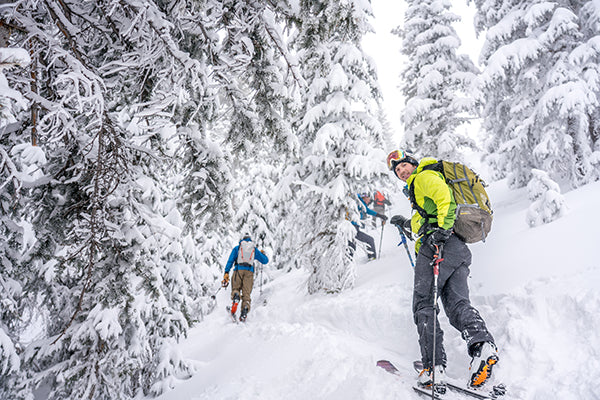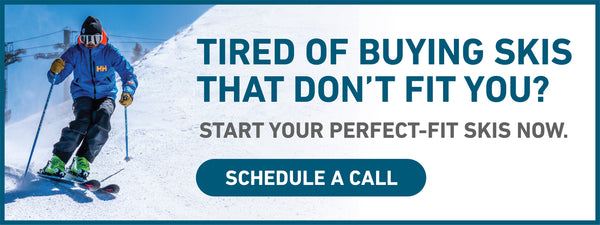
Resort Bindings 101
In terms of ski gear, most skiers gloss over what may be the most important part of their kit: bindings.
“Bindings aren’t sexy,” you may say. But you know what we think is sexy? Having both of your legs intact and unbroken.
Your bindings are critical for keeping you safe and uninjured. This is why there’s not a lot of information on the Internet around how to adjust your own—because you need a certified technician at a ski shop to do it right.

In the very best conditions, you won't even see the bindings.
Bindings are also critical for performance, too, as they are what transfer the power from your boot to your ski. That’s why, when you buy a groomer or carving ski, which requires precise power transmission, it usually comes with its own binding that’s integrated into the ski itself. Beginner skis, too, usually come with bindings for simplicity’s sake.
We at Wagner Custom sell all of our skis flat, but we prefer to mount a new binding on them ourselves (see the section on mounting point below). We sell both Marker and Salomon bindings to go with your new custom skis, but we’re also happy to put on whatever binding you want. Here’s a little primer on what you need to know about resort bindings.
The Basics
All resort bindings have a toe and heel piece and a brake. They are made to only go downhill. They do not have a walk mode, and the weight of the binding is not that important because you won’t be hauling them uphill.
DIN
DIN stands for Deutsches Institut für Normung, or German Institute for Standardization, which is the organization that established the ski industry's standard for ski binding release force settings. The DIN is essentially a scale that determines how much force is required to release a ski boot from a binding if you fall. The number is based on a skier’s height, weight, ability level, age, and boot-sole length, and bindings are set to that number on both the toe and heel.

The Marker Jester is available on our website.
A certified binding technician will match your height and weight with a release code, which is a letter between A and O. That code is combined with skier type to come up with a number (more advanced skiers get a higher DIN) and age (a lower setting is given for skiers younger than 9 or older than 50 to accommodate for higher risk of tibia fractures in those two age groups).
Bindings come with different DIN ranges, and the higher the range, the higher the price. When it comes to choosing a binding, you’ll want to buy one that has a slightly higher DIN than what you require, especially if you’re a beginner so you have room to grow. (Keep in mind that usually only people who weigh 250 pounds or more or are high-level racers need a binding with a DIN higher than 14.)
If you don’t know what your DIN is off the top of your head, look at the little window in the toe of your current bindings to tell what your number is. If you don’t have reference bindings, ask your ski designer team at Wagner to help you figure out which ones you need.
Brakes

This funny little piece will (generally) stop your skis from going too far.
All resort ski bindings come with brakes, which are little plastic arms that deploy to stop the ski from sliding downhill after it releases. Brakes come in different widths to accommodate different skis, so you’ll need to know the waist-width of the skis you’re mounting. This is the middle number in the ski’s listed dimensions, i.e., if the ski’s dimensions are 126-88-108, that means its waist-width is 88 mm. You need a brake that is 88 mm or wider, but be careful not to go too wide (no more than 12 mm), or else your brakes will get caught up in your ski pants. (Most shops will mount bindings with brakes that are up to 4 mm narrower than your skis because the brakes do stretch, but be sure to ask your shop or your Wagner designer before you pull the trigger.)
Boot Compatibility
Finally, it's important that you buy a binding that is compatible with your boots, which likely will only be an issue if you’re buying used bindings (which we don’t recommend). Most new bindings are MNC, or multi-norm compatible, which means they accommodate pretty much any kind of boots—GripWalk, Walk to Ride, older alpine boots, or alpine touring.

Look for the little GripWalk logo on your binding.
If you have relatively new alpine boots, chances are they have GripWalk soles, which are a rockered rubber sole that makes it easier to walk through an icy parking lot. If you do have GripWalk, look for the little GripWalk icon on the binding toe or check to see if it has adjustable anti-friction device (AFD). GripWalk bindings can be used for most non GripWalk alpine boots as well, but if you’re not sure, it’s best to ask your local shop.
To get the most flexibility with your choice of boots, we do recommend buying a binding that is labeled MNC.
Weight
A note on weight: For resort bindings (or resort boots, for that matter) we don’t think weight is much of a factor, as skiing is a gravity sport, after all. Weight does matter a little more when it comes to skis, as some skiers prefer less swing-weight for more maneuverability, but boots and bindings are centered on the ski and are therefore not as much of a concern.

If you aren't going uphill, you don't have to worry too much about weight.
In fact, as bindings go up in quality, they tend to go up in weight, too. Heavier bindings contain less plastic and are therefore more durable. If you ski aggressively and want your bindings to last, we recommend a higher-end binding. The weight will not affect the performance of the ski.
Mounting
One of the most important things that skiers don’t pay enough attention to is the mounting point. Chances are, you bring your skis to the shop and they probably don’t even ask you anything about your skiing before they mount your skis. That’s why we at Wagner always prefer to mount the skis we build for you according to your style and preferences.
Want to see it in action? Check out our video Factory Tour.
A traditional mount is farther back from center on the ski. This is best for skiers who spend most of their time with their skis on the ground, rather than spinning in the air. A longer tip gives the ski more float in powder and a shorter tail gives it a quicker release.
Park skiers should opt for a center mount—which, technically speaking, is a little rearward of the actual center of the ski—or a mount even farther forward than that. This gives the ski a balanced feel when spinning in the air and skiing switch.

If you spend a bunch of time in the air, consider a center mount.
The category of skier who needs the most help with their mounting point is telemarkers (yes, they do still exist). A tele ski should be mounted farther back than an alpine ski because it’s pressured by the forefoot when the skier is in a lunge.
There’s a lot more to bindings than meets the eye, so you’ll want to do more research before you purchase your next pair, but at least now you have a general idea of what to look for. If you’d prefer Wagner to take the guess work out of the equation for you on your next pair of custom skis, make an appointment with a ski designer today.
--
Article by Kimberly Beekman
Kimberly Beekman is the former editor-in-chief of the late, great Skiing Magazine (RIP), and a longtime editor of SKI Magazine before that. She currently uses the title of “freelancer” as a beard to ski powder all over the world. She lives in Steamboat, Colorado, with her wonderful daughter and terrible cat.











